
A lamb menu (more about that in yesterday’s post) would not be complete without sauces based on stock made from the bones and scraps of meat from the same lamb. And so I asked the butcher for some of the bones and used them to make a stock. Making a meat stock is very easy and doesn’t take a lot of active time. The process is the same for most types of stock, the main difference is that in lamb stock you use bones from lamb, in beef stock from beef, etc. The quality of the stock is very important to stock-based preparations such as sauces or risotto. Homemade stock made from scratch is so much better than cubes. Another advantage is that you can make it without salt, so you can simmer it down to the desired strength and only then add salt. A stock that already has salt will often become too salty if you cook it down to make it stronger.
Here’s how I made lamb stock.
Ingredients
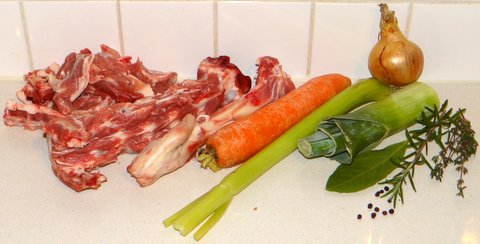
For about 1 litre/1 quart of stock
1 kilogram (2.2 lbs) lamb bones and scraps of meat
1 carrot, chopped
1 onion, chopped
1 stick celery, chopped
some fresh rosemary and thyme
1 bay leaf
some black pepper corns
Preparation
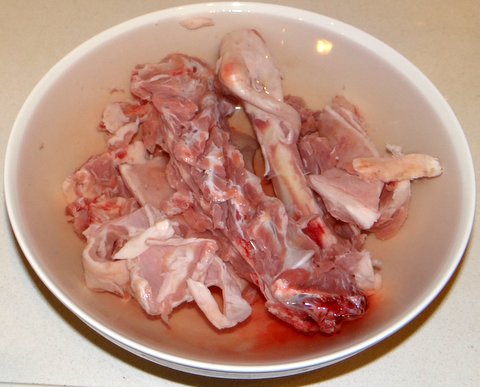
Preheat the oven to 225C/450F.
Start by soaking the bones in water to remove any excess blood. Drain and pat dry with paper towels.
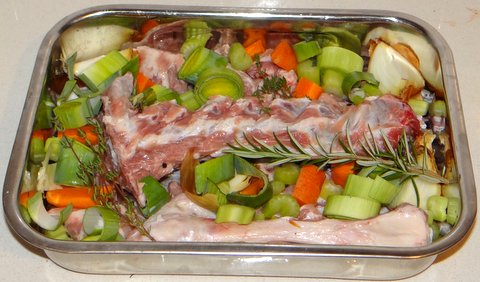
Put the lamb into an oven dish with the other ingredients. Roast in the oven at 225C/450F for 15 minutes.
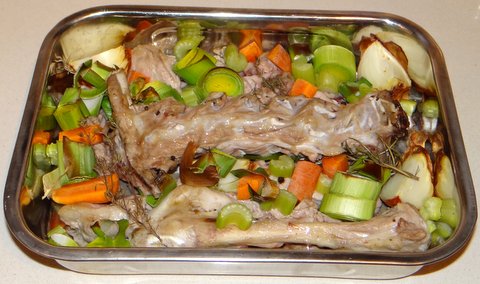
Some fat will have rendered from the meat. Toss the bones and vegetables in the oven dish to coat with the fat (and other juices) on all sides.
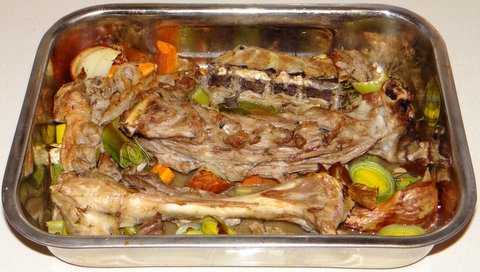
Roast for another 15 minutes until nicely browned.
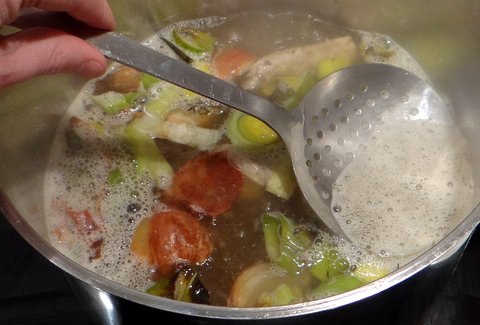
Transfer all of the contents of the oven dish, including all the juices, to a stock pot. Cover with cold water and bring to a boil. (Sometimes chicken stock is used instead of water to get a deeper flavor.)
Remove the scum that will rise to the surface using a slotted spoon.
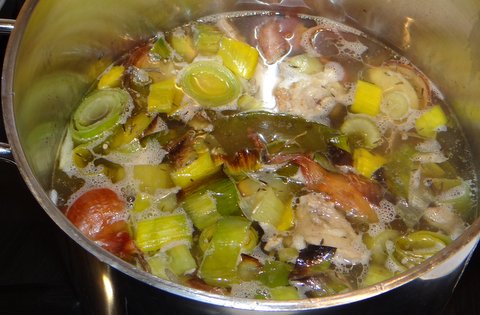
Let this simmer, uncovered, for 3 hours. The stock will become cloudy if you let it boil. This may or may not be an issue, depending on what you plan to do with the stock.

Pour the stock through a fine sieve to remove all the solids. The stock will now be relatively thin. If you’d like to use it for soup it is finished…
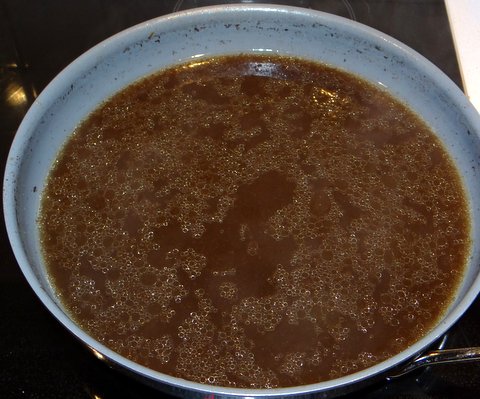
…but for a sauce or jus it’s better to simmer it over low heat to make it stronger.
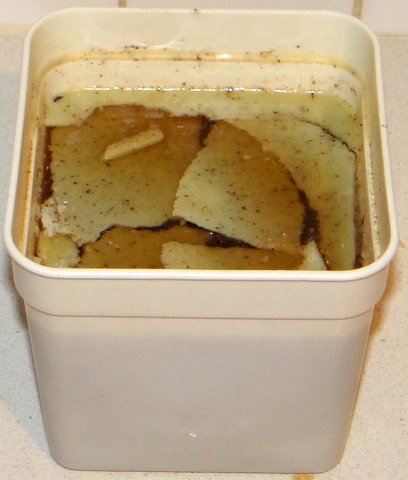
To remove the fat from the stock, allow to cool and refrigerate overnight. The fat will solidify and float on top…
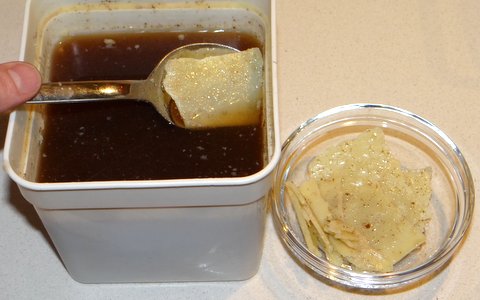
…making it easy to remove. You can discard the fat, or use it to cook with. The fat will impart an interesting lamb flavor to vegetables cooked in it.
To make a sauce from the stock, you can mount it with butter or thicken it with corn starch or a roux.
The stock can be kept in the refrigerator for a few days, or frozen for months.


I love a good lamb stock and this looks delicious. When I make it I typically reduce it down to a demi-glace because my primary use for it is in sauces. I’ve never seen the technique you used by soaking the bones in the water to draw out any excess blood. I always simply roast the bones “as is.” What affect does the excess blood have on the flavor? Does it take away some of the gaminess?
LikeLike
Removing the blood make the taste ‘cleaner’, I’m not sure if that’s the same as less ‘gamey’. There will also be less scum to deal with and it will also reduce any ‘off’ smells.
I’m lucky to have a very good source of local ‘real’ lamb, as opposed to what are often really young sheep. This lamb has a very elegant taste.
LikeLike
This is one stock I’ve not made, Stefan. I do prepare beef stock in much the same way, although I never soak the bones first. Next time I will. 🙂
Thanks for another great tip!
LikeLike
You’re welcome 🙂 I love to lamb and always try to use the proper stock for a sauce (i.e. lamb stock for a sauce with lamb, beef stock for a sauce with beef, you get the idea…)
LikeLike
Yes soaking the bones – i assume the blood contains scummy bits too? And you’re right about the salt thing – i usually use cubes and if you boil it down like you should for sauces you end up with a salty gloop – it looks okay but tastes like something you could poison yourself with
LikeLike
You are absolutely right about the scummy bits!
LikeLike
I had no idea lamb stock even existed – this is a great preparation for a product that can’t be purchased in my city. Thank you for sharing.
LikeLike
You can basically make stock out of anything. Just add water to the ingredients and simmer until you like the flavor (between half an hour for seafood and six hours for beef). Some ingredients (like cabbage) are less nice in a stock though. If you use the search box and my blog and type “stock”, you will find many recipes. Shrimp stock is amazing!
LikeLike
Oh my. Shrimp stock – yes, please. I often make chicken stock with the usual suspects – carrots, onions, leeks, garlic, celery, etc. etc. I love that you have a plethora of stock recipes – I will refer to your blog for all things STOCK! 🙂
LikeLike
I will soon have a recipe for rabbit stock 🙂
LikeLike
🙂 I look forward to it!
LikeLike
Hi Stefan!
I really like your stock recipes and I’m looking forward to prepping this one. I am curious why didn’t you use pressure cooker when making lamb stock, though you seem to use it when making other types of stock. Could you elaborate, please?
Best regards from Poland!
LikeLiked by 1 person
Hi Karol,
The only reason is that when I wrote the recipe for lamb stock, I wasn’t using a pressure cooker to make stock yet. It is certainly a good idea to use a pressure cooker for lamb stock. About 1.5 hours should be sufficient.
LikeLike